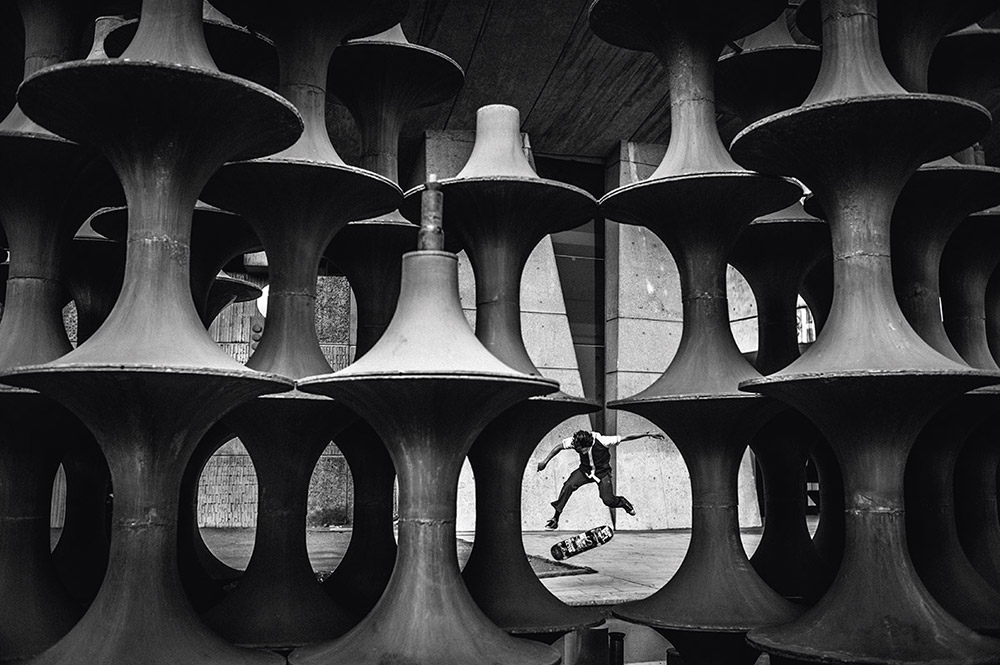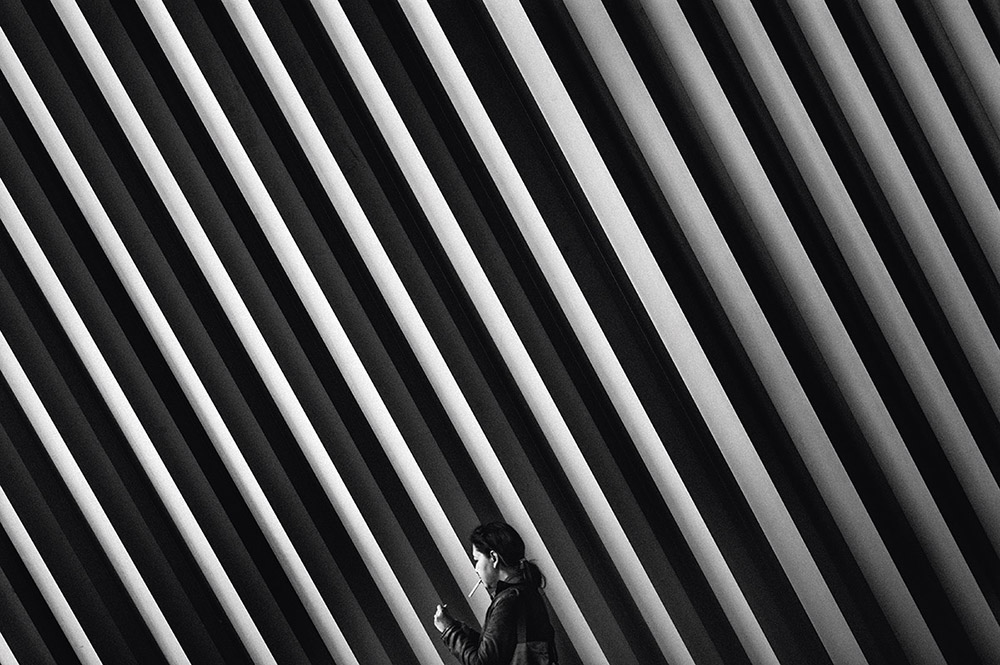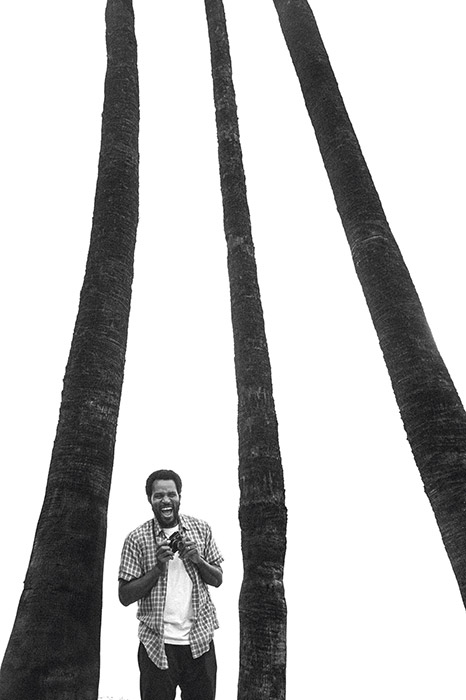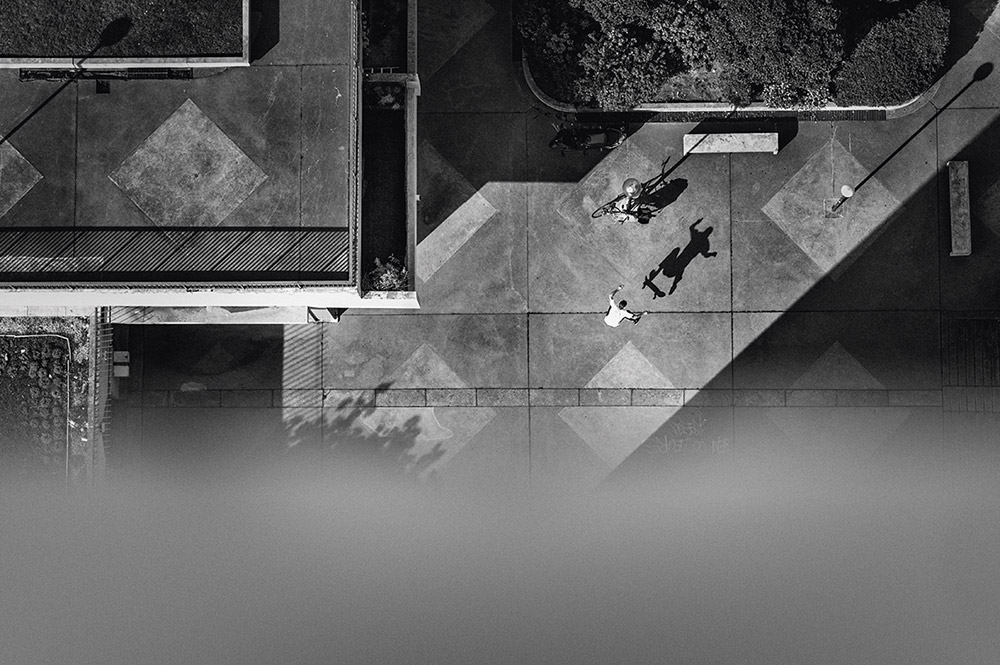When you look at Fred Mortagne’s pictures, you instantly want to shoot some photos yourself cause everything seems so attainable. He doesn’t need three flashes or special lenses but just shoots with his Leica and even relinquishes color. You could say the only tool he uses is his eye, like he already did around 15 years ago when he gave some groundbreaking videos to skateboarding. It seems the pictures are just lying there, waiting to be taken by him, but it’s not that easy. Every detail has to be in place when he “steals” those special moments from reality in a glimpse of a second. That’s why his first book, which will be published in the next couple of days by Thomas Campbell’s Um Yeah Arts, is titled Attraper au vol (Catch in the Air). In there, you can find a collection of those pictures that gain maximal strong expression created with minimum equipment, just with this special view on the world that the man from Lyon has.
It’s refreshing for me to shoot other things than skating and I use
my style to shoot different things, not just skaters. I can’t come up
with hundreds of skate pictures, they’re gonna start looking the same.
It’s interesting to transfer the skateboarding approach to other things.
When a skateboarder looks at a city, you see things other people don’t
see.

Steeve Ramy | Varial Flip
Exactly. I like to do both, so I can bring a different approach to skateboarding and can produce fresh images. When there are big trends in skateboarding, you tend to do the same because it’s inspiring and it’s the only thing you see. It’s good to refresh your mind and your eyes with other things.
"Skateboarding is much richer than just the action."
It’s not so much that I had influences but more a feeling of what I wanted to express and share with people. In skateboarding we make videos in certain ways, the magazines have to be a certain way because we focus on the action – but skateboarding is much richer than just the action. I think because I was doing the videography which was about the performance, I was missing the other side of skateboarding: the more aesthetical things. When I started shooting photos, I had no clue about photography, I didn’t know any other photographers besides all the skate photographers. Surely I was influenced by Dan Sturt because his photography was really different from the rest and very progressive and creative. He was really trying to bring something new. He was maybe the first guy whose work showed me that there are other things to see in skateboarding. But when it comes to street photography, I kinda let myself go. I have some ideas of visuals I’m looking for, but I go with the inspiration and just walk around. It’s more of an inside feeling. When I see a thing, I want to capture it.

I think it came from kind of a frustration that when you’re filming, the things you show are always in motion. You can’t just freeze one frame. As I was filming, I started to have ideas of pictures and then I looked at the photographers and they would not shoot what I saw, they had other ideas. So I thought: “Let’s get a camera and capture it.” I’ve always worked with both video and photography because I can’t choose between the two. Sometimes I’m all about video because I like editing to the music, playing around with the footage, but sometimes I’m missing the photography side of things. Then I leave video on the side for a few weeks and only focus on photography. I’m always back and forth. If I shoot too much photography, at some point I’m gonna get bored and make some videos again.
Not really, because it’s kinda difficult. When I film, I don’t want to fuck up the footage, so I’m focusing on the filming and usually there is always a photographer, so the photo gets shot by someone else, which is frustrating in a way. And most of the time you cannot ask the guy to do it again. So instead I’ve been focusing on filming and once it’s over, I’ll ask the guy to do a different trick. Maybe something simple, a flatground trick. That’s why there’s lots of simple tricks in my pictures. Because usually it’s at the end of the session and you have five minutes before we move on. The skater is already tired, so I’m just like: “Hey, do a kickflip for me.” It’s always been in these rushed moments. I have to be fast to capture these moments and I’m always limited in time. But Sturt was the same, he did video and photography and he is the only guy I know who did it the same time. He went on missions with Geoff Rowley and set up a camera on a tripod with a wideangle lens and he filmed while holding the remote control.

Now it’s more similar than it used to be because back in the days I was making videos for companies and the videos were about the action. So, my photography approach was really different because it was much more personal and not about any marketing or stuff like that. But with so many videos on the internet, you don’t want to make the same project over and over again, so I naturally started to take some of my style from photography into my videography. So they started to have a similar approach cause I was trying to express the same things. That’s why I also started to do projects like Hybridation which was trying to mix both. I mean through my career I always tried to mix it up as much as possible, mix stills and animations with the video footage. There’s many different ways to mix both mediums. Hybridation was a video, but I shot it with a photographic approach. I focused on the compositions and almost didn’t move and there was minimum motion. It was kinda like photographies but on video.
It’s freestyle and depends on the project. I’m working with Element and I’ve been doing a lot of editing lately. I’ve edited Jarne’s [Verbruggen] part for Thrasher. I like editing, even if I didn’t film the footage myself. Mostly I try to make every day different from the day before. I always work on different projects at the same time, so there is no routine and I don’t get bored. Right now I’m working on my book, but I also edit some promo clips for the book that give a behind-the-scenes look.

Evan Smith | Ollie
It depends, there aren’t any rules. At the fullpipe session I did have a picture in mind and we shot it. But then I kept looking around and found new ideas, which turned out to be better, and the original idea was in fact the less interesting. Sometimes I have a precise idea and we go and shoot it and that’s it and sometimes it’s the opposite way around. Sometimes you go to a spot and find an angle, but there might be other angles. It’s always good to go back to a spot when it’s possible. For example the plaza in Lyon, where I started filming 20 years ago. I put a picture in the book which I shot recently from a building, looking down on the plaza. I never thought about that before. It took me 20 years to figure it out at a spot I thought I knew by heart. And if other photographers will go to the same place, they will find their own angles. Sometimes I see a photo of a spot I went to and think: “Oh, the picture is so good! Why didn’t I think about that?” I’ve always been fascinated by the fact that we can all see interesting things in different ways from the same scene. If you go to the Eiffel Tower, there’s no point of shooting it, because it has been shot a million times, but no, there’s still an idea to find and there are still some really good pictures to shoot – even in 2016. You just have to stay open and be curious.
Ideally I’d like to be able to shoot some more difficult tricks. Cause there starts to be some repetition in what I do if I only shoot kickflips and backside flips. But for me, it was a natural way how I did it. I was not a full-time photographer, so I had to adapt to the conditions I had: limited time, end of the session. But I thought that was great in a way cause we rarely show that kind of stuff in a magazine, because skateboarding is so much marketing and competition between the companies, so everybody has to be the best. For many years, it had to get bigger and bigger, but it’s not just about that. It’s also about having fun and skateboarding is a lot about style, that’s super important. But in media or videos we kind of forget about it because it’s all about the action. It was not easy to get pictures into magazines, because for a long time they didn’t really care about showing easy tricks. It was about the biggest stunts and the best tricks, which I understand, but now things are different and that’s cool.

I don’t think so, because if I shoot a picture without a skateboarder in it, to me there would be missing something. I almost never shoot plain architecture, it’s almost too easy. I started to shoot some stuff to use it with other pictures, but on their own, I don’t like a picture of just a building and I like the interaction of a skateboarder and the architecture. That’s what I want to show. That’s why I’m stepping back and show small skateboarders – to show how they interact with the environment and how they can skateboard in places that are not meant for skateboarding. In my pictures you have architecture, environment, and the skateboarder. If you take out the skateboarder, the picture becomes really weak. They are really important and I’m not taking photos of every kind of skateboarder. I have the chance to work with the best guys and those who have the best style. For me, it’s really important to have a really good skateboarder cause it makes a big difference. It’s not about being good technically but about the style, that’s really crucial. If I have an idea of a picture or find a spot, then I think about who would be the best to do something there. I think I’m good at knowing which guy to bring to which spot. Sometimes I was wrong, so I came back again with another guy and finally it was good. [laughs]
"It’s not about being good technically but about the style, that’s really crucial."
Right now I just use my Leica and no flashes and nothing. I can do all the stuff I need to do with it. I’m not a technical guy when it comes to photography. For a long time, I was just an amateur photographer, just doing it alongside videography. I was on a different level and had to come up with something completely different. I could not carry flashes with me anyway, cause I already had too much equipment and I didn’t have time to set them up as I had to work fast. So it was just due to the conditions, but it suits me cause I do like natural light and I don’t know how to set up flashes so that it looks good. I can do basic stuff, but I’m not good, so I’m doing my own thing.

For a long time I also shot color photos, but over time I naturally went towards black and white because it is the most powerful look. It was working well with the composition and the photographic visual style I wanted to achieve. I do like black and white a lot. I don’t know why. The black and white is helping to give the pictures a more artistic touch. It takes you away from reality and I try to create scenes that look a little surreal and strange. If I use color, you’re gonna be too much connected with reality and it’s not gonna make you travel mentally. And it’s timeless. Some pictures you don’t know when they’ve been shot. When I was a kid, I’ve always been intrigued by black and white films. When you look at these old movies, it’s really hard to imagine that the reality was like today. When I was a kid, I thought that in 1900 the life was in black and white. With my photography, I can add a certain weird thing and stay away from reality.
I thought for a long time that I have to make a book, but I knew I couldn’t do it myself. I had a few proposals from different people I didn’t know, so I wasn’t sure and waited for the right time. Then Thomas Campbell asked me to do it and I thought: “Now is the right time!” I respect him very much and love what he does. He suggested it two years ago.
I trusted him a lot. We worked together on a first selection of pictures and then we tried to think about some layout ideas. I told him the things I like although I’m not good as a graphic designer. We kind of walked a general direction and then he did the layout with one of his design friends. There were some surprises in the way it was layouted and some pictures he took and others got left on the side. But then he explained to me all of his ideas and the flow and it all made sense. For Thomas, the reading flow is really important, which is really hard to find. When you read books you might not understand everything, but things are in a certain way and a certain flow and it feels right and you can’t explain why. He told me many times that it was very difficult for him to find a layout. He was like: “Ah, your photography is very strong and you got so many strong pictures, we can’t put all that stuff in and we have to mix it with other pictures, so your brain is not gonna explode when you go through the book.” That’s why he brought in some pictures I would’ve never thought of, but they bring some breathing between very strong pictures.
I think in skateboarding we have the wrong idea that to talk about skateboarding we have to show skateboarding. That’s not right. You don’t have to always show a crazy trick.

Sammy Winter | Frontside Flip